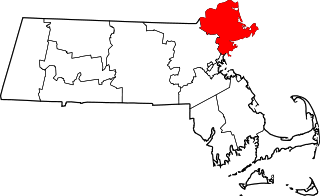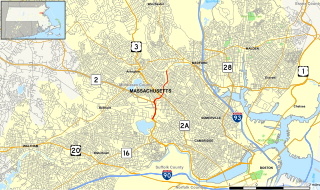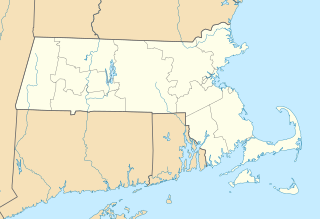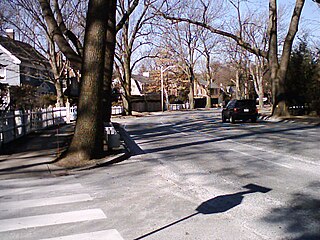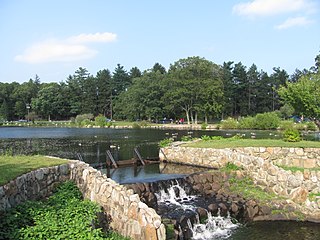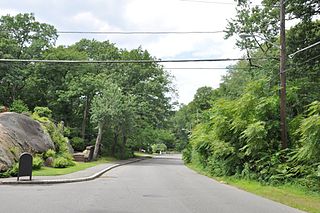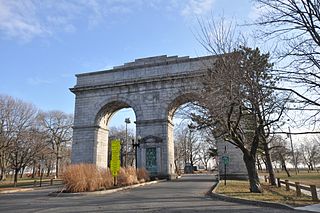Nahant Beach Boulevard-Metropolitan Park System of Greater Boston | |
| Location | Lynn and Nahant, Massachusetts |
|---|---|
| Coordinates | 42°26′12″N70°56′17″W / 42.43667°N 70.93806°W Coordinates: 42°26′12″N70°56′17″W / 42.43667°N 70.93806°W |
| Built | 1936 |
| Architect | Eliot, Charles; et al. |
| MPS | Metropolitan Park System of Greater Boston MPS |
| NRHP reference # | 03000747 [1] |
| Added to NRHP | August 11, 2003 |
Nahant Beach Boulevard, also Nahant Causeway and Nahant Road is a historic road on the isthmus connecting Nahant, Massachusetts to the mainland at Lynn, Massachusetts. The road runs from the Lynn Rotary, its junction with Lynn Shore Drive and the Lynnway, about 1.5 miles (2.4 km) to Wilson Road in Nahant. It passes through Nahant Beach Reservation, a state park offering beach access on the isthmus. The road offers expansive views of the area coastlines and Boston Harbor. [2] Both the park and the roadway are administered by the Massachusetts Department of Conservation and Recreation.

An isthmus is a narrow piece of land connecting two larger areas across an expanse of water by which they are otherwise separated. A tombolo is an isthmus that consists of a spit or bar, and a strait is the sea counterpart of an isthmus.

Nahant is a town in Essex County, Massachusetts, United States. The population was 3,410 at the 2010 census, which makes it the smallest municipality by population in Essex County. With just 1.0 square mile (2.7 km2) of land area, it is the smallest municipality by area in the state. It is primarily a residential community.

Lynn is the 9th largest municipality in Massachusetts and the largest city in Essex County. Situated on the Atlantic Ocean, 3.7 miles (6.0 km) north of the Boston city line at Suffolk Downs, Lynn is part of Greater Boston's urban inner core. Settled by Europeans in 1629, Lynn is the 5th oldest colonial settlement in the Commonwealth. An early industrial center, Lynn was long colloquially referred to as the "City of Sin", owing to its historical reputation for crime and vice. Today, however, the city is known for its contemporary public art, international population, historic architecture, downtown cultural district, loft-style apartments, and public parks and open spaces, which include the oceanfront Lynn Shore Reservation; the 2,200-acre, Frederick Law Olmsted-designed Lynn Woods Reservation; and the High Rock Tower Reservation. Lynn also is home to Lynn Heritage State Park, the southernmost portion of the Essex Coastal Scenic Byway, and the seaside, National Register-listed Diamond Historic District.
Nahant Beach Boulevard was first laid out in 1905, as part of the Metropolitan District Commission's program of developing oceanfront parkways, and provided the first paved road access to Nahant. It was designed by the firm of Olmsted, Olmsted, and Eliot, predecessor to the Olmsted Brothers landscape design firm. Around the same time, rail access and a bridle path were also added to the isthmus. [2]

The Department of Conservation and Recreation (DCR) is a state agency of the Commonwealth of Massachusetts, situated in the Executive Office of Energy and Environmental Affairs. It is best known for its parks and parkways. As of December 9, 2015, the Commissioner of the DCR is Leo Roy. The DCR's mission is "To protect, promote and enhance our common wealth of natural, cultural and recreational resources for the well-being of all." The agency is the largest landowner in Massachusetts.

The Olmsted Brothers company was an influential landscape architectural firm in the United States, established in 1898 by brothers John Charles Olmsted (1852–1920) and Frederick Law Olmsted, Jr. (1870–1957), sons of the eminent landscape architect Frederick Law Olmsted.
In 1936 that roadway alignment was converted into a parking area, and the present roadway was completed the following year on the alignment of the railroad bed. The Lynn Rotary was completed in 1935. This work, along with the conversion of the bridle path to a promenade, was paid for by Works Progress Administration grants. Since then modifications to the roadway have been modest. Seawalls have been built, a chain link fence was installed on the wall between the road and the parking lot, and the rotary was landscaped. [2]

The Works Progress Administration was an American New Deal agency, employing millions of people to carry out public works projects, including the construction of public buildings and roads. It was established on May 6, 1935, by Executive Order 7034. In a much smaller project, Federal Project Number One, the WPA employed musicians, artists, writers, actors and directors in large arts, drama, media, and literacy projects. The four projects dedicated to these were: the Federal Writers’ Project (FWP), the Historical Records Survey (HRS), the Federal Theatre Project (FTP), the Federal Music Project (FMP), and the Federal Art Project (FAP). In the Historical Records Survey, for instance, many former slaves in the South were interviewed; these documents are of great importance for American history. Theater and music groups toured throughout America, and gave more than 225,000 performances. Archaeological investigations under the WPA were influential in the rediscovery of pre-Columbian Native American cultures, and the development of professional archaeology in the US.
When the roadway was listed on the National Register of Historic Places in 2003, the designation included, in addition to the roadway itself, the Lynn Rotary and the Spanish–American War Memorial located in the rotary; a second memorial, the Aliferis Monument, postdates the period of significance for the listing. [2]

The National Register of Historic Places (NRHP) is the United States federal government's official list of districts, sites, buildings, structures, and objects deemed worthy of preservation for their historical significance. A property listed in the National Register, or located within a National Register Historic District, may qualify for tax incentives derived from the total value of expenses incurred preserving the property.

The Spanish–American War was an armed conflict between Spain and the United States in 1898. Hostilities began in the aftermath of the internal explosion of USS Maine in Havana harbor in Cuba, leading to U.S. intervention in the Cuban War of Independence. The war led to emergence of U.S. predominance in the Caribbean region, and resulted in U.S. acquisition of Spain's Pacific possessions. That led to U.S. involvement in the Philippine Revolution and ultimately in the Philippine–American War.




